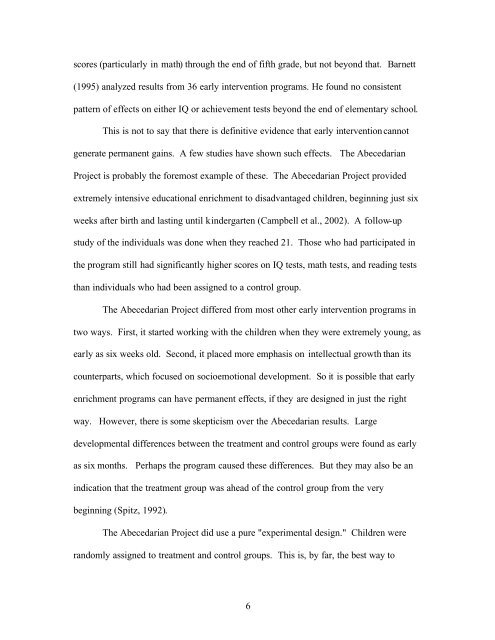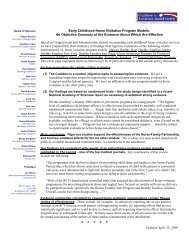Do Early Childhood Intervention Programs Really Work? - Social ...
Do Early Childhood Intervention Programs Really Work? - Social ...
Do Early Childhood Intervention Programs Really Work? - Social ...
You also want an ePaper? Increase the reach of your titles
YUMPU automatically turns print PDFs into web optimized ePapers that Google loves.
scores (particularly in math) through the end of fifth grade, but not beyond that. Barnett<br />
(1995) analyzed results from 36 early intervention programs. He found no consistent<br />
pattern of effects on either IQ or achievement tests beyond the end of elementary school.<br />
This is not to say that there is definitive evidence that early intervention cannot<br />
generate permanent gains. A few studies have shown such effects. The Abecedarian<br />
Project is probably the foremost example of these. The Abecedarian Project provided<br />
extremely intensive educational enrichment to disadvantaged children, beginning just six<br />
weeks after birth and lasting until kindergarten (Campbell et al., 2002). A follow-up<br />
study of the individuals was done when they reached 21. Those who had participated in<br />
the program still had significantly higher scores on IQ tests, math tests, and reading tests<br />
than individuals who had been assigned to a control group.<br />
The Abecedarian Project differed from most other early intervention programs in<br />
two ways. First, it started working with the children when they were extremely young, as<br />
early as six weeks old. Second, it placed more emphasis on intellectual growth than its<br />
counterparts, which focused on socioemotional development. So it is possible that early<br />
enrichment programs can have permanent effects, if they are designed in just the right<br />
way. However, there is some skepticism over the Abecedarian results. Large<br />
developmental differences between the treatment and control groups were found as early<br />
as six months. Perhaps the program caused these differences. But they may also be an<br />
indication that the treatment group was ahead of the control group from the very<br />
beginning (Spitz, 1992).<br />
The Abecedarian Project did use a pure "experimental design." Children were<br />
randomly assigned to treatment and control groups. This is, by far, the best way to<br />
6




